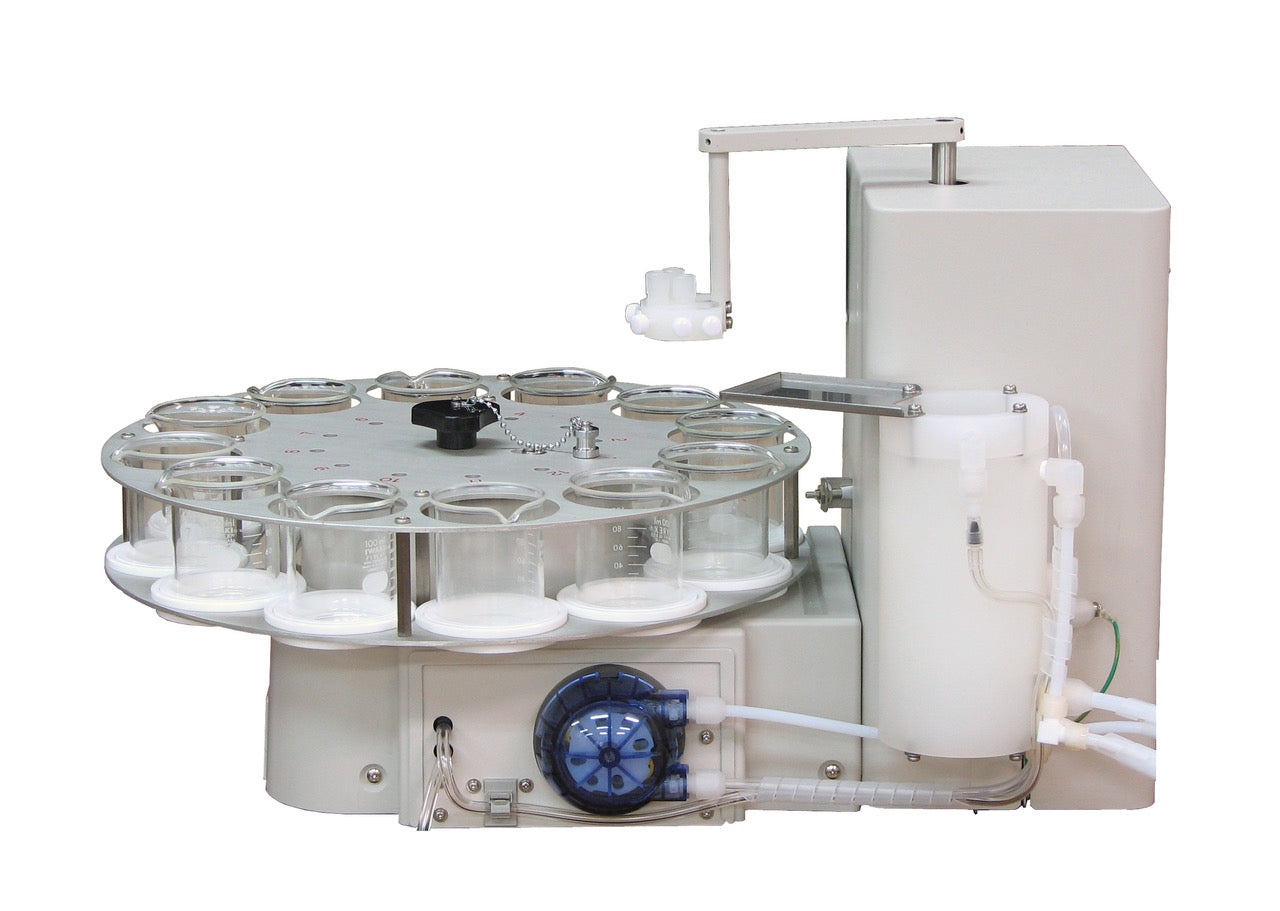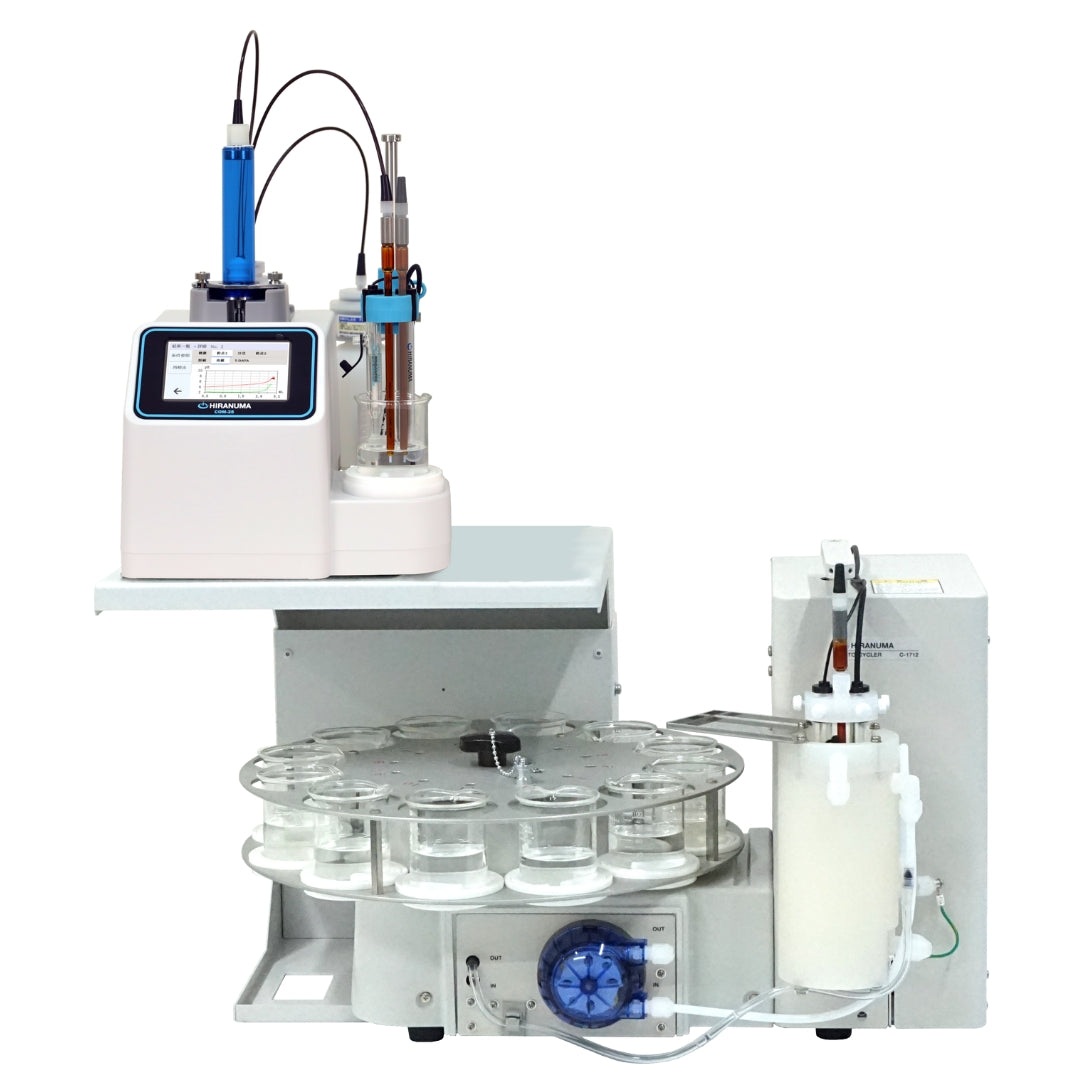| HIRANUMA APPLICATION DATA | Automatic Titrator | Data No. | H1 | Oct. 7,2022 |
| SODA PULP INDUSTRY | Purity determination of sodium hydroxide |
1. Abstract
Sodium hydroxide is one of the most elemental reagent in chemical industrial reagents. Its production amount is large and it is used in a broad range of fields. Sodium hydroxide absorbs carbonate gas and water in atmosphere because of its properties, the purity of sodium hydroxide is gradually reduced. Japanese Industrial Standard (JIS) K8576 defines determination method for purity of sodium hydroxide (titration with indicator). Representative impure substance in sodium hydroxide includes sodium carbonate.
This report introduces an example for the quantitative determination of sodium hydroxide purity and sodium carbonate by successive and fractional potentiometric titration.
First, sodium carbonate is precipitated as barium carbonate by adding barium chloride before the titration (formula (1)). Secondly, most sodium hydroxide is titrated with highly concentrated hydrochloric acid standard solution. After that, residual sodium hydroxide is titrated with low-concentrated hydrochloric acid standard solution. It enhances the accuracy of quantitative determination for sodium hydroxide. Barium carbonate generated on pretreatment is continuously titrated with low-concentrated hydrochloric acid standard solution. The titrated volume for carbonate is doubled compared with the procedure without adding barium chloride, so it is especially available for the small amount determination of carbonate.
| Na₂CO₃ + BaCl₂ → BaCO₃↓ + 2NaCl (Pretreatment) | ・・・(1) |
| NaOH + HCl → NaCl + H₂O | ・・・(2) |
| BaCO₃ + 2 HCl → BaCl₂ + CO₂ + H₂O (Titration) | ・・・(3) |
The reaction between sodium hydroxide and hydrochloric acid is described in formula (2). Formula (3) shows the reaction between barium carbonate and hydrochloric acid. The pHs reach 9 and 4 on the reaction (2) and (3) at each end point.
2. Configuration of instruments and Reagents
| (1) | Configuration | ||
| Main unit | : | Hiranuma Automatic Titrator COM series | |
| Option | : | One buret | |
| Electrode | : | Glass electrode GE-101B | |
| : | Reference electrode RE-201Z *Instead of above electrodes, the following combination electrodes are usable. ・GR-501BZ (Fixed sleeve type) ・GR-511BZ (Flexible sleeve type) |
||
| (2) | Reagents | ||
| Titrant | : | 1.0 mol/L Hydrochloric acid standard solution 0.1 mol/L Hydrochloric acid standard solution |
|
| Additive | : | 10 % Barium chloride solution | |
3. Measurement procedure
| (1) | Take about 1.5 g of sample into 200 mL beaker and accurately weigh it. |
| (2) | Add 50 mL of DI water which does not contain carbon dioxide, and dissolve the sample. |
| (3) | Add 10mL of 10 % barium chloride solution. Flow nitrogen gas to the headspace on sample solution with 300 mL/min flow rate. |
| (4) | Immerse the electrodes with keeping nitrogen gas flowing, and start titration. 1.0 mol/L hydrochloric acid standard solution is dispensed first (35 mL here)*, and secondly 0.1 mol/L hydrochloric acid standard solution is titrated. *Addition amount of 1.0 mol/L hydrochloric acid is equivalent to 90 % of sodium hydroxide in sample solution. |
4. Measurement conditions and results
Examples of titration conditions
(1) Dispense 1.0 mol/L hydrochloric acid
| Cndt No. | 1 | |
| Method | Disp | |
| Buret No. | 1 | |
| S-Timer | 5 | sec |
| Disp.Vol. | 35 | mL |
(2) Titration of sodium hydroxide
| Cndt No | 2 | |
| Method | Auto | |
| Buret No. | 2 | |
| Amp No. | 1 | |
| D. Unit | pH | |
| S-Timer | 5 | sec |
| C.P. mL | 0 | mL |
| T Timer | 0 | sec |
| D.P. mL | 0 | mL |
| End Sens | 1000 | |
| Over mL | 0 | mL |
| Max .volume | 40 | mL |
| ConstantNo. | 2 | |
| Size | 1.5002 | g |
| Blank | 35 | mL |
| Molarity | 0.1 | mol/L |
| Factor | 1.004 | |
| K | 40 | |
| L | 1.001 | |
| Unit | % | |
| Formula | ||
| (D*F*M+B*L)*K/(S*10) | ||
| Digits | 3 | |
|
Auto input Parameter
|
None | |
| Mode No. | 5 | |
| Pre Int | 0 | sec |
| Del K | 5 | |
| Del Sens | 0 | mV |
| Int Time | 3 | sec |
| Int Sens | 3 | mV |
| Brt Speed | 2 | |
| Pulse | 40 | |
*Enter the dispensing volume and factor of 1.0 mol/L hydrochloric acid standard solution in B (Blank) and L (coefficient 2), respectively.
(3) Titration of sodium carbonate (sodium carbonate)
| Cndt No. | 3 | |
| Method | Auto | |
| Buret No. | 2 | |
| Amp No. | 1 | |
| D. Unit | pH | |
| S-Timer | 0 | sec |
| C.P. mL | 0 | mL |
| T Timer | 0 | sec |
| D.P. mL | 0 | mL |
| End Sens | 500 | |
| Over mL | 0.2 | mL |
| Max. volume | 2 | mL |
| ConstantNo. | 3 | |
| Size | 1.5002 | g |
| Blank | 0 | mL |
| Molarity | 0.1 | mol/L |
| Factor | 1.004 | |
| K | 53 | |
| L | 0 | |
| Unit | % | |
| Formula | ||
| (D-B)*K*F*M/(S*10) | ||
| Digits | 3 | |
|
Auto input Parameter
|
None | |
| Mode No. | 8 | |
| Pre Int | 0 | sec |
| Del K | 5 | |
| Del Sens | 0 | mV |
| Int time | 5 | sec |
| Int Sens | 3 | mV |
| Brt Speed | 2 | |
| Pulse | 40 | |
Measurement results
Measurement results of sodium hydroxide
| Number of measurement |
Size (g) |
Titrant volume(mL) |
Concentration (%) |
|---|---|---|---|
| 1 | 1.5396 | 22.998 | 97.023 |
| 2 | 1.5002 | 13.590 | 97.052 |
| 3 | 1.5110 | 15.970 | 96.991 |
| Statistic calculation |
Average | 97.02 % | |
| Standard deviation | 0.031 % | ||
| Coefficient of variation | 0.03 % | ||
Measurement results of sodium carbonate
| Number of measurement |
Size (g) |
Titrant volume(mL) |
Concentration (%) |
|---|---|---|---|
| 1 | 1.5396 | 1.236 | 0.429 |
| 2 | 1.5002 | 1.152 | 0.409 |
| 3 | 1.5110 | 1.085 | 0.382 |
| Statistic calculation |
Average | 0.407 % | |
| Standard deviation | 0.024 % | ||
| Coefficient of variation | 5.80 % | ||
Examples of titration curves

5. Note
Atmosphere environment
Atmosphere contains about 0.03 % carbon dioxide. When carbon dioxide is absorbed into sample solution during titration for sodium hydroxide, the titrant volume consumed for sodium hydroxide is decreased, while it is increased on the titration for sodium carbonate. Flowing nitrogen gas to the headspace on sample solution serves as an effective measure against this problem. Using air passed through soda lime absorption column instead of nitrogen gas also has a positive effect.
Keywords:Sodium hydroxide, Sodium carbonate, Neutralization titration, Barium carbonate, JIS K 8576
*Some measurement would not be possible depending on optional configuration of system.









